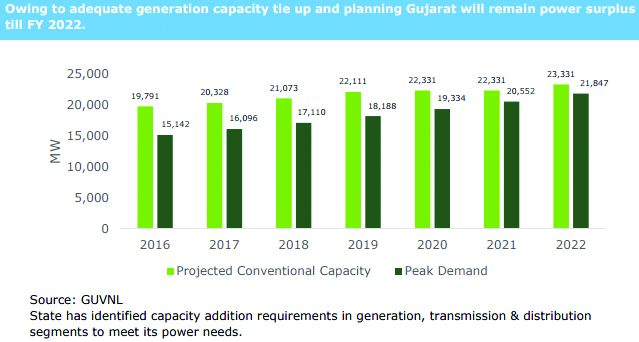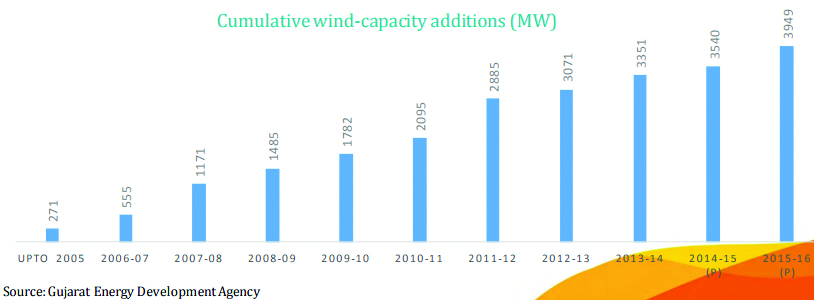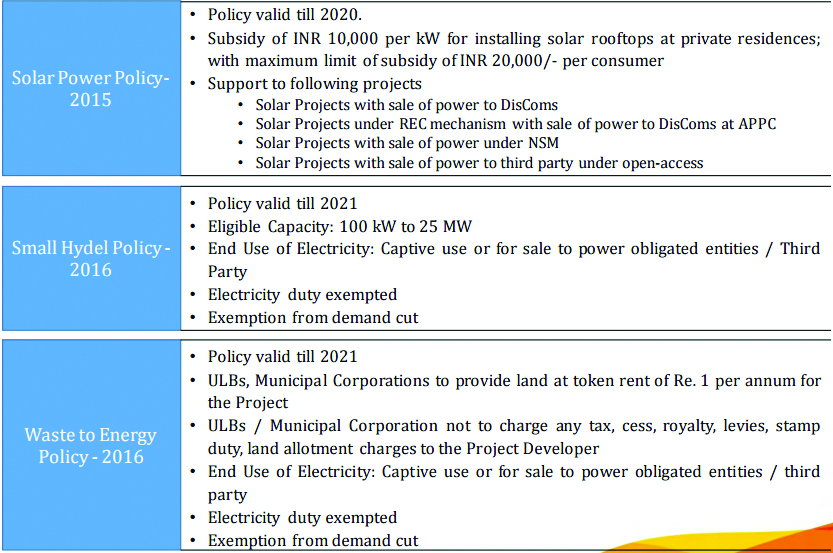
State of Art Solar Power Park Project – Charanka Gujarat

Gujarat has an installed capacity of around 30394.29 MW. 22.94% of this is contributed by Renewable Energy (RE) Source. The state has planned augmentation of generation capacity considering current demand supply situations as well as demand from upcoming consumers. Gujarat has remained frontrunner in climate efficient initiatives by adapting various policies for promoting sustainable energy sources. Another sig. fact that contributes to excellent power conditions in state is the dominance of Pvt. players in the generation sector. Pvt. sector contributes to around 61.49% of total power generation followed by State Utilities with 25.35% and Central Plants having contribution of 13.14%. The regulations and new policies have given a positive momentum to capacity addition in past years. Generation capacity addition in Coal based thermal plants has been significant along with solar & wind. Two of the largest Power Projects in the country i.e. 4620 MW (Adani Mundra Project) and 4000 MW ( Mundra UMPP of Tata Power) is located in the Gujarat. Torrent Power is operating 3130 MW of conventional power projects in different parts of the State. In last six years state utilities has added capacity of 7,214 MW in coal, 1,429 MW in gas, 2424 MW in wind and 1127 MW in Solar projects. By 2022 state utilities has planned to add 3540 MW from conventional sources. During the same time it is expected that around 8000 MW from renewable sources will be available in the state. RE generation in state will lead to sustainable development. Gujarat is on the verge of infrastructure revolution. State’s gross domestic product has been rising at growth rate of 9.3% over the decade. State is involving integrated developments of large areas like SIRs, PCPIR and DMIC to transform the industrial scenario in the state. India’s first SEZ for global financial services GIFT emerges as a fore runner of new opportunities in Gujarat. Owing to the high pace of development peak demand of State is expected to reach 21,847 MW by FY 2022 at a CAGR of 6.3%. State has made adequate planning to meet the upcoming demand. Considering the focus of GoI on promoting RE sources State would be required to add 8000 MW of RE by 2022. [...]

Gujarat is a renewable rich state and is witnessing frequent deviation in schedules due to variability in RE generation. In case the RE generation is excluded while working out the deviation at inter-state level, the impact of the RE generation would be minimized and would encourage further augmentation of RE sources. Alternatively, RE power may be absorbed in the national grid so that the generating stations of the State Utilities are not subjected to cyclic loading. The state has undertaken several initiatives leading to increased Pvt. participation in generation segment and has achieved consistency in capacity addition to meet its rising demands. Some of the initiatives take up by state for promotion of the sector are as follows. State has emphasized on increasing power generation from renewable sources such that RPO obligated entities like Discoms will able to meet their targets. To promote solar as well as non-solar power generation GERC has set separate RPO targets in each category. In order to promote solar power generation State has come up with Solar rooftop Net metering regulation & Solar pump schemes where in power generated can be used for captive consumption and excess power can be sold to third party or state distribution companies. State of Art Solar Power Park Project – Charanka Gujarat: Proposed capacity more than 750 MW. Currently 350 MW commissioned. Land selected 2000 Ha Govt. Waste Land for development of the Park. Enables accelerated development of solar project through availability of suitable land common infrastructure grid connectivity water availability. Solar Canal Top Projects: State commissioned the world’s first canal-top solar power project over 750m on Narmada branch canal new in Mehsana district of 1MW capacity producing 1.6 MU/year/MW. Another 10MW Sardar Sarovar canal top project has been made operational in 2014 generating 16.2 MU/year. Solar Rooftop Project: For promotion of distributed power generation the state has developed solar rooftop projects of 5 MW at Gandhinagar and 4 MW at Vadodara. For wider consumer participation the state has rolled out the solar policy 2015 with special emphasis to solar rooftop project. Subsidy of Rs. 10,000/KW (maximum 2 KW) is provided by the state for these projects. Upcoming Ultra-Mega Solar Power Park Project: Capacity more than 700 MW. Proposed to be built on 1,407 Hectare of waste land in Banaskantha district. MNRE released grant of Rs. 30 Cr through SECI to GPCL for development of this project. MNRE/GoI will provide central finance assistance of Rs. 20 lakh / MW based on achievement of milestone. Energy efficiency adoption is gaining momentum in Gujarat. GEDA is State Nodal Agency for MNRE and State Designated Agency for BEE. It works on RE & energy conservation policies framework and their implementation in State. It also undertakes investment grade energy audits on Govt buildings including offices, educational institutes. Some of the other initiatives are as follows. State has broadened fuel base by adding renewable capacity over last few years. State is developing gas network & LNG terminals for improving gas availability. 1st state to implement Energy Efficient pump sets in Agri sector. Conducting Energy conservation awareness & training programs. Implementing energy efficiency programs like Domestic Efficient Lighting Program, National LED Street Lighting Program, Super-Efficient Fan Program & PAT scheme in State. RE resources are remotely located from the load centers. Due to variabality of RE generation the system operator is facing issues of grid management. State Regulatory Commission has incorporated scheduling of wind and solar generators in its Grid code in 2016. Forecasting is done by generators & SLDC is ensuring secured grid operation. Technical collaboration with Academia like IIT’s, NIT’s for solving RE grid integration issues and optimum utilization of transmission line is an initiative taken for promoting transmission sector by Gujarat. And in order to evacuate electricity form large capacity RE projects state transmission utility GETCO has made financial provision of 1,737 Cr to add 1,570 ckm of dedicated transmission lines with capacity of around 6,160 MVA by FY 2020. The State has a potential of 35,000MW in wind energy and 69,000MWin solar energy. Gujarat houses one of the Asia’s largest solar park. After a feasibility study of Indian offshore wind potential, Gujarat is one of the two states that has been selected as ideal to feature the first Indian offshore wind farm. The state with a ~1600km coastline also has a potential of 8200 MWin tidal energy. Gujarat has the 4th largest Wind Power installed capacity in the country which is about 3948.61 MW (as on March 2016). The Centre for Wind Energy Technology, an autonomous R&D institution under MNRE, has identified and approved 40 sites for wind energy deployment with annual average wind power density greater than 200 W/sq. m. at a 50 m heightin Gujarat. Over a period of last more than 25 years more than 65 sites have been monitored for the wind speed and wind power density, and over 50 sites havebeen foundfeasible for harnessingwind power.

Gujarat has over 1GW of installed solar capacity, accounting for ~17% of India’s total. Gujarat also has Asia’s First Solar Park in Village Charanka,Ta:Santalpur, Patan in 2024 hectares of wasteland. For setting up 3000MW Generation & Manufacturing Facilities. 345 MW Capacity Power Plants havebeen installed at Charanka Solar Park. 91 plants totaling to about 1121 MW capacity were commissioned in Gujarat up to March 2016. The total bio-mass potential for Gujarat is about 1,800 MW from crop residue and about 140 MW from forest residue. 41.10 MW capacity biomass projects commissioned in Amreli,Junagadh and Vadodara. 14.389 MW waste-to-energy power generation projects. Institutionalbiogas plants with capacity15730 m3/day across the state. Gujarat has initiated the world’s first canal-based solar power project on Narmada branch canal new Chandrasan village of Mehsana district. Energy generated from this pilot project will be directly fed into the local electricity grid and utilized by nearby towns and villages Gandhinagar: The Model Solar City project: GoI declared to develop Gandhinagar as a Model Solar City setting an example for Solar Cities throughout India and other nations. Two solar projects with cumulative installed capacity of 2000kWinstalledin the city. 7415 kW Grid Tied RoofTops installedunder the Solar City Project. Wind-solar hybrid system with 60 KW capacity installed in the city. The Model Solar City project has led to an annual savingsof 149.20 lacskWh in Gandhinagar. The project has helped reduce 14,900 tons of carbon emission and avoidusageof 10,430 tons of coal. Gandhinagar & Vadodara Solar Rooftop Programme: This Programme provides an opportunity to property owners in Gandhinagar City for participation by offering their rooftop or terrace for installation of Solar Photovoltaic System for solar power generation. 5 MW solar rooftops have been setup in Gandhinagar as part of the Model Solar City Project on Govt and Pvt. households. 328 locationshavebeen covered in Gandhinagar including 276 households and 52 Govt Buildings. The programme has been replicated in Vadodara too where solar rooftops with capacity of ~4 MW are setup. The owner of property is paid a “Green Incentive” on the basis of units (kWh) of electricity generated by the SPV system installed on the property.











leave your comment